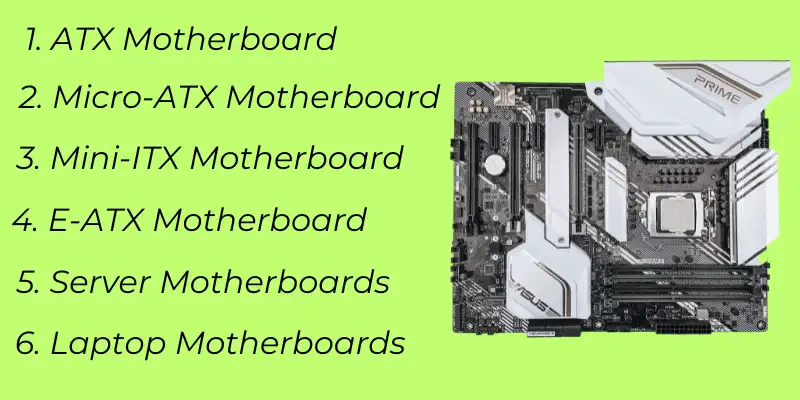6 Types of Motherboards Explained – Make the Right Choice!
Published: 20 Mar 2025
Building or upgrading a PC? Before purchasing any laptop parts, the motherboard should be your main priority. It functions as the backbone of your computer, deciding which processor, RAM, and storage you can use. What do ATX, Micro-ATX, and Mini-ITX all mean? Relax if you can’t decide which motherboard is best for you. This article on 6 types of motherboards will help you select the best choice for your system. Let’s break it down so that everyone understands.
What is a Motherboard?
A motherboard is the primary circuit board that links all of a computer’s hardware parts. It serves as the hub for the processor, RAM, storage, and other devices. Without a motherboard, a computer is useless. Several types of motherboards are built for a specific device, such as desktops, laptops, gaming rigs, and servers.
Major Types of Motherboards
Several types of motherboards are available, categorized by size, compatibility, and functionality. Below are the main types of motherboards, along with their pros and cons.
- ATX Motherboard
- Micro-ATX Motherboard
- Mini-ITX Motherboard
- E-ATX (Extended ATX) Motherboard
- Server Motherboards
- Laptop Motherboards

1. ATX Motherboard (Advanced Technology eXtended)
ATX motherboards are full-size and commonly used in desktop PCs. They have several expansion slots, making them suitable for gaming and professional workstations. With numerous upgrade possibilities and enhanced connections. ATX motherboards serve consumers who require high performance and future-proofing in their systems.
| Pros: |
|---|
|
| Cons: |
|---|
|
2. Micro-ATX Motherboard
Micro-ATX is a smaller version of ATX, offering fewer expansion slots but still maintaining great performance. It’s commonly used in budget gaming and office PCs, providing a balance between functionality and affordability.
| Pros: |
|---|
|
| Cons: |
|---|
|
3. Mini-ITX Motherboard
Mini-ITX motherboards are intended for compact, energy-efficient PC designs. They are suited for small form factor (SFF) computers, such as HTPCs and portable gaming systems. These boards are designed to reduce space while still providing basic functionality, however they have limited upgrade options.
| Pros: |
|---|
|
| Cons: |
|---|
|
4. E-ATX Motherboard (Extended ATX)
E-ATX motherboards are designed for high performance and versatility, making them ideal for gamers, professionals, and content creators. These boards offer several GPUs, fast storage, and smart cooling solutions, which make them perfect for demanding computing tasks such as 3D rendering, AI processing, and high-end gaming.
| Pros: |
|---|
|
| Cons: |
|---|
|
5. Server Motherboards
Server motherboards are made to support high-performance computing, cloud storage, and business uses. They prioritize dependability and security, making them important for servers and enterprises that require consistent performance.
| Pros: |
|---|
|
| Cons: |
|---|
|
6. Laptop Motherboards
Laptop motherboards are designed to suit every single laptop model, including the processor, RAM, and storage components. They are designed to be power-efficient and compact, resulting in lightweight and portable designs while limiting upgradeability.
| Pros: |
|---|
|
| Cons: |
|---|
|
How to Choose the Right Motherboard
When selecting a motherboard, consider these key factors:
Purpose – Are you building a gaming PC, workstation, or office computer?
Form Factor – Ensure the motherboard fits your PC case (ATX, Micro-ATX, Mini-ITX, etc.).
Processor Compatibility – Check whether it supports Intel or AMD CPUs.
Expansion Slots – Need multiple GPUs, extra RAM, or additional storage?
Connectivity – Look for Wi-Fi, Bluetooth, USB, and SATA ports based on your needs.
Choosing the right motherboard ensures smooth performance, future upgradeability, and system stability.
Also Read This Articles
8 Different Types of Microphones
10 Types of Computer Keyboards
Discover the Laptop Screen Types
Discover the Different Types of Webcams
Discover Different Types of Laptops| Choose the Best for You
10 Types of Speakers and Their Uses
10 Common Types of Computer Viruses
Types of Laptop Chargers Explained
10 Different Types of Computer Mouse
10 Types of Laptop Ports | Which Ones Do You Really Need?
Types of Laptop Processors Learn Intel Core, Dual Core, AMD
Explore All Laptop Accessory Types
Top 5 Types of Laptop Bags for Students and Professionals
Types of Laptop Battery: Understanding Li-ion, LiPo, & More
The ATX motherboard is the most commonly used in desktop PCs, offering expandability and versatility.
Yes, but you must ensure compatibility with your CPU, RAM, and power supply before upgrading.
ATX and E-ATX motherboards are best for gaming as they support multiple GPUs, RAM slots, and high-speed components.
Check the CPU socket type, RAM compatibility, case size, and power supply support to ensure compatibility.
Yes, laptop motherboards are custom-built for specific models and are not easily replaceable like desktop motherboards.
Conclusion
Selecting the best motherboard is important when building or upgrading a computer. ATX and E-ATX are ideal for gaming and high-end performance, whereas Micro-ATX and Mini-ITX are suitable for cheap and compact PC builds. Server motherboards are excellent for business use, while laptop motherboards are designed specifically for each model. To ensure a smooth and effective computing experience, consider compatibility, expansion options, and affordability before purchasing.

- Be Respectful
- Stay Relevant
- Stay Positive
- True Feedback
- Encourage Discussion
- Avoid Spamming
- No Fake News
- Don't Copy-Paste
- No Personal Attacks



- Be Respectful
- Stay Relevant
- Stay Positive
- True Feedback
- Encourage Discussion
- Avoid Spamming
- No Fake News
- Don't Copy-Paste
- No Personal Attacks





